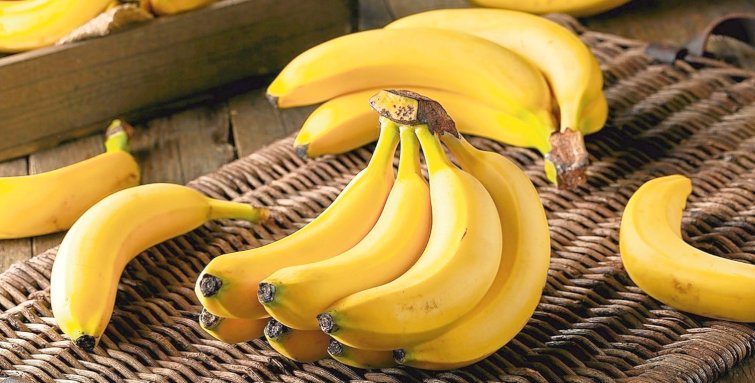It appears that bananas — especially overripe bananas — may trigger headaches in some people with certain health conditions, such as migraines.
This potential adverse effect of bananas stems from their high tyramine content, a natural compound found in plants and animals.
“Tyramine can cause headaches by constricting and dilating blood vessels,” points out Penn Medicine.
In this article, we’ll investigate the potential relationship between bananas and headaches.
Bananas and Headaches
Because bananas are quite nutritious and consumed throughout the world, hearing that bananas may lead to headaches can come as a surprise.
In fact, whether or not eating bananas triggers headaches has not been tested with scientific studies!
However, patient self-reports tell us that ripe and overripe bananas might be potential headache triggers for some people, especially for those who are sensitive to tyramine {1, 2, 3}.
“Ripe bananas and avocados can be potent headache triggers because they contain high amounts of tyramine,” says Jennifer Kriegler (MD), a neurology specialist at the Cleveland Clinic.
Let’s find out how tyramine might induce headaches in some individuals. This will in turn tell us why tyramine-rich bananas are linked to headaches.
Tyramine and Headaches
First, it is important to note that tyramine is not a harmful substance! It presents in some foods and seems to help regulate blood pressure, among other functions in the human body {4, 5, 6}.
For most people, the body is able to process (break down) tyramine effectively with a digestive enzyme called monoamine oxidase.
However, some people have low levels of monoamine oxidase. This can be genetic or because of certain medications they use {7, 8, 9, 10}.
Having low levels of monoamine oxidase in the body is called tyramine sensitivity.
If a tyramine-sensitive person eats foods high in tyramine, too much tyramine can build up in his/her body, leading to certain complications.
According to Queensland Health, a high level of tyramine in the blood can increase blood pressure and cause severe headaches among other symptoms.
Medical experts believe that some migraine patients are tyramine sensitive, so they are likely to experience headaches and other associated symptoms when they consume tyramine-rich foods {11, 12, 13, 14, 15, 16}.
Since bananas contain a significant amount of tyramine, they are linked to headaches. This is especially true with overripe bananas because the tyramine level increase as the fruit ages.
As per Reports; Bananas May Induce Headaches
The Cleveland Clinic posted an article titled “Headaches and Foods”. The article contains a list showing the foods associated with headaches. Unsurprisingly, ripe bananas are on the list! “The information used to prepare the list mostly comes from patient self-reports, not from scientific studies,” indicates the Cleveland Clinic.
The American Headache Foundation listed tyramine-containing foods that may trigger headaches. On the list, bananas are inside the “Use With Caution” column.
Physicians Committee listed common food triggers that often cause headaches in susceptible individuals. Bananas — along with many other healthy foods such as onions, tomatoes and nuts — are on the list.
The University of California, Berkeley published an article about headaches. The article contains a list of potential dietary migraine triggers. Overripe bananas are on the list. The article also indicates that migraine sufferers should eat no more than ½ banana per day.
Tyramine Content of Bananas
Tyramine levels increase in foods when they age. This certainly applies to bananas as well.
For this reason, some experts advise migraine patients to avoid eating ripe and overripe bananas.
The question is: how does a person understand whether a banana is ripe or overripe?
If there are any dark or brown patches – however small – on the banana, it means that the fruit is very ripe.
If the fruit contains too many brown patches covering most of the fruit, then the fruit is overripe and therefore contains a very high amount of tyramine {6, 17}.
The below image shows an example of overripe bananas.

Some studies suggest that banana peels contain way more tyramine than the pulp {17, 18}.
The National Headache Institute advise migraine sufferers that: if you don’t avoid eating bananas altogether, at least remove the stringy pieces of inner peel that stick to the banana.
Are Bananas Headache Trigger For You?
The American Migraine Foundation suggests that migraine patients should try to identify potential food triggers for them and limit their consumption.
If you suspect that eating bananas give you headaches, then consider removing bananas and other tyramine-rich foods from your diet for about 2 weeks.
If your symptoms improve during this process, it may signify that you are tyramine sensitive.
A 2016 study concluded that identifying personal migraine-inducing foods and then restricting their consumption can be an effective and reliable way to reduce the number of migraine episodes.
Note: To be able to effectively identify potential dietary triggers for migraine, you may want to work with a dietitian who specialises in migraine diet.
The Bottom Line
In this article, we explained why bananas — which offer many health benefits — are linked to migraine headaches. The culprit is tyramine!
As mentioned above repeatedly, especially overripe bananas contain a significant amount of tyramine; therefore can induce headaches in tyramine-sensitive people.
If you find that bananas trigger headaches in you, then it is very likely that other tyramine-rich foods such as nuts, avocados, and aged cheeses make the same impact.
Headache specialists suggest that those who suffer from migraine may want to limit their tyramine intake to reduce the number of migraine episodes {3, 11, 13}.
Whether bananas or anything else; whatever the cause of your constant headaches which lowers your quality of life, we encourage you to work with your doctor.
